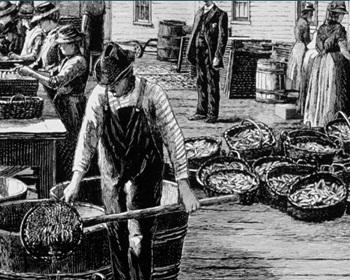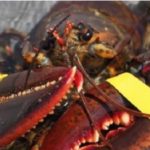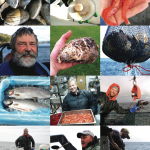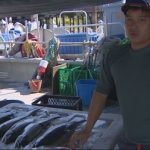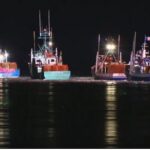Tag Archives: “river herring
More alewives swim up the restored Bagaduce watershed
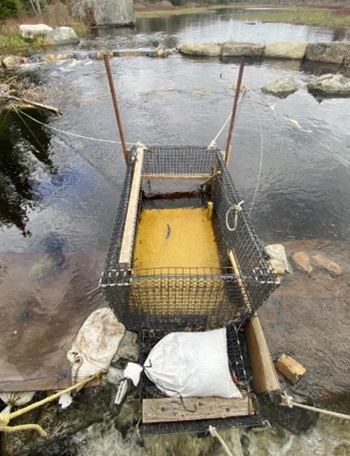 More than two years after the completion of multiple fish passage projects in western Hancock County, the effort appears to be paying off as alewives swim in greater numbers up the Bagaduce River watershed each spring. Those and other projects have contributed to a resurgence in the upstream migration of alewives, which are a key food supply for bigger wildlife, as well as a growing source of income for Maine fishermen who sell them as food or springtime lobster bait. From 2017 through 2021, the towns of Penobscot, Sedgwick and Brooksville worked with conservation groups to remove barriers that prevented fish from migrating between the tidal Bagaduce River and five ponds in its watershed. The idea was to help restore runs for fish, especially alewives, that travel upstream from Penobscot Bay and reproduce in the ponds more, >>CLICK TO READ<< 14:55
More than two years after the completion of multiple fish passage projects in western Hancock County, the effort appears to be paying off as alewives swim in greater numbers up the Bagaduce River watershed each spring. Those and other projects have contributed to a resurgence in the upstream migration of alewives, which are a key food supply for bigger wildlife, as well as a growing source of income for Maine fishermen who sell them as food or springtime lobster bait. From 2017 through 2021, the towns of Penobscot, Sedgwick and Brooksville worked with conservation groups to remove barriers that prevented fish from migrating between the tidal Bagaduce River and five ponds in its watershed. The idea was to help restore runs for fish, especially alewives, that travel upstream from Penobscot Bay and reproduce in the ponds more, >>CLICK TO READ<< 14:55
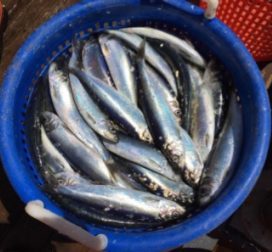
Fishermen’s Alliance: Long-Waged Battle for Herring Won
The formal announcement from the National Oceanic and Atmospheric Administration reflected what much of the Cape wanted, a 12-nautical mile territorial sea boundary from the Canadian border to Connecticut and a 20-mile buffer off the peninsula’s backshore as well as catch limits based on the needs of the ecosystem. Supporters believe the buffer that keeps industrial-sized midwater trawl vessels from taking enormous amounts of herring out of local waters will go a long way towards rebuilding the entire inshore ecosystem and therefore boost the maritime economy. >click to read< 10:10
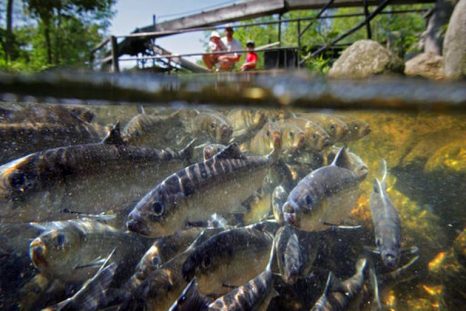
Habitat: River Herring, key to coastal health, slowly returning to rivers
A little fish on the East Coast that once provided vital protein for American colonists and bait for generations of New England lobstermen is slowly making a comeback after falling victim to lost habitat and environmental degradation. River herring once appeared headed to the endangered species list, but they’re now starting to turn up in rivers and streams at a rate that fishing regulators say is encouraging. The fish is a critical piece of the ecosystem in the eastern states, where it serves as food for birds and larger fish. >click to read<14:06
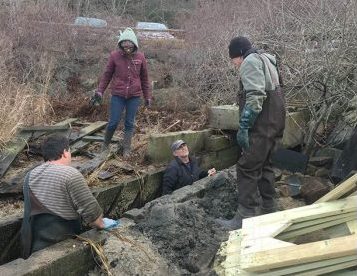
Islanders, officials discuss the dire state of river herring
Local fishermen, tribe and town officials, state and federal officials, and concerned citizens gathered Monday in the cavernous Wampanoag Tribe of Gay Head (Aquinnah) Community Center to discuss the troubling decline in the river herring population on the Vineyard, and along the eastern seaboard.,,, The decimation done by offshore fishing was a recurring theme in the discussion. “Ninety-five percent of the public doesn’t know how much harm the midwater trawlers are doing,” charter fishing captain, and Aquinnah Deputy Shellfish Warden Buddy Vanderhoop said. Vanderhoop said the trawlers off the New England coasts are also decimating groundfish stocks, such as cod, haddock, flounder, and pollock. >click to read< 13:19
Cape Groups say Stop wiping out herring close to shore
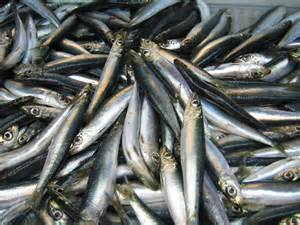 Herring loom large in the history of Cape Cod — it’s no coincidence that pretty much all of our towns have a “Herring River,” nor that one of the first public positions created in Colonial days was “herring warden,” charged with overseeing one of the community’s most important economic resources… In an effort to preserve the species, we have stopped people from scooping up so much as a single herring from our runs. Yet millions of river herring are killed just offshore and denied the chance to reproduce. It makes no sense.This is only one reason the Association to Preserve Cape Cod and the Cape Cod Commercial Fishermen’s Alliance have come together to call on federal regulators to create a buffer zone around the Cape to stop midwater herring trawling in our waters. click here to read the story 21:59:
Herring loom large in the history of Cape Cod — it’s no coincidence that pretty much all of our towns have a “Herring River,” nor that one of the first public positions created in Colonial days was “herring warden,” charged with overseeing one of the community’s most important economic resources… In an effort to preserve the species, we have stopped people from scooping up so much as a single herring from our runs. Yet millions of river herring are killed just offshore and denied the chance to reproduce. It makes no sense.This is only one reason the Association to Preserve Cape Cod and the Cape Cod Commercial Fishermen’s Alliance have come together to call on federal regulators to create a buffer zone around the Cape to stop midwater herring trawling in our waters. click here to read the story 21:59:
Maine’s river herring making dramatic comeback
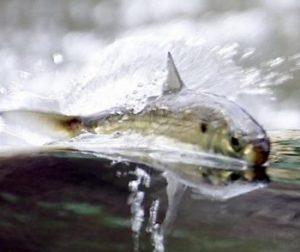 River herring – in the midst of a dramatic comeback in Maine’s rivers with the recent removal of dams that blocked their spawning runs for decades – had a banner spring run this year, with millions of fish traveling up the Kennebec and Penobscot and the best run in decades recorded on the St. Croix. This was despite heavy rains this spring that created extra challenges for the fish. The recovery of the small schooling fish is having dramatic secondary effects, as they represent a perfect food source for everything from bald eagles to Atlantic cod, and researchers anticipate future benefits as the herring’s numbers grow in the coming decade. click here to read the story 10:10
River herring – in the midst of a dramatic comeback in Maine’s rivers with the recent removal of dams that blocked their spawning runs for decades – had a banner spring run this year, with millions of fish traveling up the Kennebec and Penobscot and the best run in decades recorded on the St. Croix. This was despite heavy rains this spring that created extra challenges for the fish. The recovery of the small schooling fish is having dramatic secondary effects, as they represent a perfect food source for everything from bald eagles to Atlantic cod, and researchers anticipate future benefits as the herring’s numbers grow in the coming decade. click here to read the story 10:10
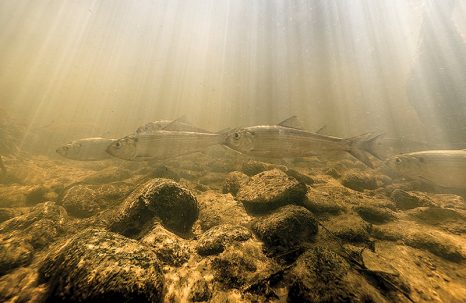
Sonar revealing more river herring in Choptank River than expected
Scientists have a powerful new tool to help them “see” fish in the Chesapeake Bay’s murky tributaries, and it’s yielding some surprisingly good news about two of the estuary’s most troubled species. “Imaging sonar” uses sound to help them view, and count, passing fish in dark or cloudy water. For the past few years, scientists with the Smithsonian Environmental Research Center have been deploying one of these underwater sound cameras in some of the Bay’s rivers to monitor spawning runs of alewife and blueback herring, collectively known as river herring.,,No one knows for sure how many river herring are in the Bay, as fisheries managers lack the staff and resources to do a comprehensive assessment. But a SERC-led team of scientists deployed an imaging sonar device in the Choptank River in 2014 that captured images of the fish as they swam by. Based on the rate at which scientists saw the shadowy blips cross their computer screens, they estimated that as many as 1.3 million river herring swam upriver that spring to spawn. That’s more than expected, and way more than state biologists had figured were there in the early 1970s, the last time anyone looked intensively at the Choptank’s herring runs. Read the article here 10:14
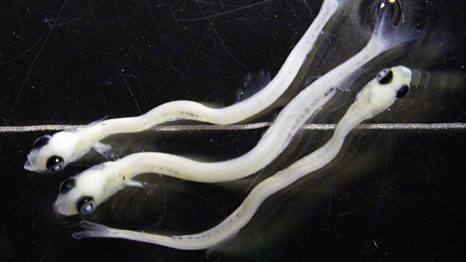
A Big Decline of River Herring – Tiny stones in fish hold clues to help restore populations
Many New Englanders still recall the vast springtime runs of river herring. Millions of the small silvery fish swam up coastal freshwater streams, returning from the sea to spawn. Two species of river herring, alewives and blueback herring, are critical components of marine food webs, right up to the fishermen on shore and at sea who harvest them. But in the late 1960s, herring populations sharply declined to as little as one percent of their historic size. Ever more-efficient commercial fishing fleets have swept them up in coastal waters. But even after states banned or limited catches, the fish have not rebounded. To expand access to historical spawning habitats, some communities have also begun removing dams. In 2014, Joel Llopiz launched a project, funded by Woods Hole Sea Grant, with colleagues at the Massachusetts Division of Marine Fisheries. The researchers are collecting and examining larval herring in four coastal river/pond systems of different sizes in Massachusetts. The systems also vary in their impacts from pollution, urban development, and agriculture. Continue reading here with more images 15:42
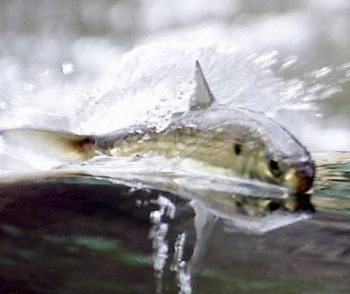
Trouble for Bay State River herring trapped by drought in Lakeville, Middleboro, Rochester
The historic drought trapped at least a million young river herring in Assawompsett Pond as they tried to swim out to the ocean, and a state biologist says countless more are likely stuck up and down the Massachusetts coast. The water in Assawompsett has been too low to flow over the spillway that leads to the Nemasket River, on the Lakeville-Middleboro line. Each spring, adult herring make their way upstream to spawn. Hatchlings spend the summer in inland waters. In late summer, fall, and into the winter, young fish swim out to the ocean. If they get stuck, it can present some problems. “My understanding is they can winter over if they have to, but it’s not a preferred option,” Cavanaugh said. If the water gets too cold, or if an ice cap reduces oxygenation, it can kill fish. Read the story here 08:30
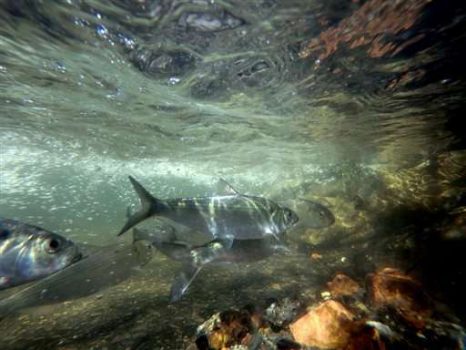
River Herring spawn in NY tributary for 1st time in 85 years
A few days after a long-abandoned industrial dam was removed from the mouth of a Hudson River tributary this spring, hundreds of river herring swarmed up into the shallow waters to spawn for the first time in 85 years. The removal of the rusted steel dam on the Wynants Kill near Albany was the first of what ecologists hope will be many barriers removed in Hudson tributaries to restore spawning habitat for herring and other ocean-going species that have been devastated by habitat loss, pollution and overfishing. “There are more than 1,500 dams in the Hudson estuary watershed, most of them no longer in use,” said Frances Dunwell, coordinator of the state Department of Environmental Conservation’s Hudson River Estuary Program. “One of the key items on our to-do list by 2020 is to remove as many of these barriers as possible.” Read the rest here 12:01
New England Fishery Management Council reject expanded protections for herring
 In a decision lauded by state regulators and decried by environmentalists, federal regulators ruled this week that a plan to extend greater conservation efforts to river herring is not necessary at this time. There is a need for more data to assess river herring and shad stocks, but the factors affecting the species include water quality and fish passage, which are difficult to address through federal management plans, said Jeff Nichols, a spokesman for the state Department of Marine Resources. Read the rest here 14:25
In a decision lauded by state regulators and decried by environmentalists, federal regulators ruled this week that a plan to extend greater conservation efforts to river herring is not necessary at this time. There is a need for more data to assess river herring and shad stocks, but the factors affecting the species include water quality and fish passage, which are difficult to address through federal management plans, said Jeff Nichols, a spokesman for the state Department of Marine Resources. Read the rest here 14:25
Connecticut: River herring returning to state waterways
 Two factors have contributed to the local river herring boom: a new culvert built at Rocky Neck in 2009 reopened a previously constricted channel; and beaver dams upstream of Latimer Brook that had cut the fish off from ponds where they mate and spawn have been removed,, theday Read more here 10:03
Two factors have contributed to the local river herring boom: a new culvert built at Rocky Neck in 2009 reopened a previously constricted channel; and beaver dams upstream of Latimer Brook that had cut the fish off from ponds where they mate and spawn have been removed,, theday Read more here 10:03
Is NOAA studying river herring to death?
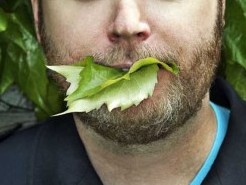 If you’ve been following the (mis)management of river herring over the last few years, you may not even be surprised at the latest shenanigans of the NOAA fisheries officials: a delay tactic in the form of a “working group.” Read more here 10:57
If you’ve been following the (mis)management of river herring over the last few years, you may not even be surprised at the latest shenanigans of the NOAA fisheries officials: a delay tactic in the form of a “working group.” Read more here 10:57
New Mashpee fish ladder and dam will aid key species to food chain, river herring
 The river herring that will primarily use the ladder are so important to the local ecosystem, said state Sen. Daniel Wolf, D-Harwich, that the project should be viewed as a boon to the entire Cape. “Protecting the fishing industry starts here,” he said. “If we don’t protect the bottom end of this, it doesn’t matter what we do with fishing quotas.” more@capecodtimes 08:52
The river herring that will primarily use the ladder are so important to the local ecosystem, said state Sen. Daniel Wolf, D-Harwich, that the project should be viewed as a boon to the entire Cape. “Protecting the fishing industry starts here,” he said. “If we don’t protect the bottom end of this, it doesn’t matter what we do with fishing quotas.” more@capecodtimes 08:52
Genetic study of river herring populations identifies conservation priorities – Most by catch in Mid Atlantic and Southern New England
 A genetic and demographic analysis of river herring populations along the U.S. east coast, published October 2 in Evolutionary Applications, has identified distinct genetic stocks, providing crucial guidance for efforts to manage their declining populations. [email protected] 15:57
A genetic and demographic analysis of river herring populations along the U.S. east coast, published October 2 in Evolutionary Applications, has identified distinct genetic stocks, providing crucial guidance for efforts to manage their declining populations. [email protected] 15:57
Regulators in New England cap river herring catch
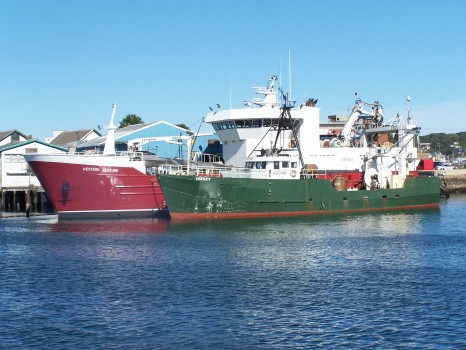 The caps proposed Thursday by the New England Fishery Management Council during their meeting on Cape Cod target so-called mid-water trawlers, which catch herring by pulling a large net between them. The caps limit the trawlers to a total of 500,000 pounds of river herring in three areas off New England. [email protected] 17:15
The caps proposed Thursday by the New England Fishery Management Council during their meeting on Cape Cod target so-called mid-water trawlers, which catch herring by pulling a large net between them. The caps limit the trawlers to a total of 500,000 pounds of river herring in three areas off New England. [email protected] 17:15
Return of alewives on St. Croix River celebrated
 BAILEYVILLE, Maine — For nearly 20 years, conservationists and, at times, state natural resource agencies, have sought to open the St. Croix River watershed to alewives,,, continued
BAILEYVILLE, Maine — For nearly 20 years, conservationists and, at times, state natural resource agencies, have sought to open the St. Croix River watershed to alewives,,, continued
It isn’t clear what has led to the increase, but River Herring numbers up in NH, although still far short of past years
“They were a huge part of the ecosystem here, especially in near-shore environments where everything eats them – fish, seals, gulls, ospreys,” said Matt Carpenter, fisheries biologist for New Hampshire Fish and Game. “Historicall y, they were one of the species that ran up all the rivers all along the coast, but were wiped out by dams, some overfishing issues, ocean predation and other ocean issues, predation (in fresh water) by striped bass.” continued
y, they were one of the species that ran up all the rivers all along the coast, but were wiped out by dams, some overfishing issues, ocean predation and other ocean issues, predation (in fresh water) by striped bass.” continued
Restoration efforts put spotlight on once plentiful alewives (“river herring,”)
BDN – Despite alewives being the focus of sometimes contentious efforts to improve their access to Down East Maine freshwater spawning habitats, these migratory fish remain something of a mystery to many, while at the same time remaining a favorite food for wide variety of Maine wildlife. continued
Maine Governor LePage allows alewives bill to become law
Eighteen years ago, the Legislature approved a blockade that prevented alewives from running up the St. Croix River. In this June 4, 2005 file photo, alewives congregate in the Damariscotta Mills fishway, in Nobleboro,  Maine. An 18-year-old blockade on the St. Croix River will be lifted in a few days. (AP Photo/Robert F. Bukaty) In a historic decision that largely went unnoticed, that blockade will be lifted in a few days after Gov. Paul LePage opted not to veto L.D. 72. The bill takes effect Tuesday. The emergency legislation requires the state to ensure, by May 1, that the fishways on the Woodland Dam and the Grand Falls Dam be reconfigured or operated in such a way that “allows the unconstrained passage of river herring.” continued
Maine. An 18-year-old blockade on the St. Croix River will be lifted in a few days. (AP Photo/Robert F. Bukaty) In a historic decision that largely went unnoticed, that blockade will be lifted in a few days after Gov. Paul LePage opted not to veto L.D. 72. The bill takes effect Tuesday. The emergency legislation requires the state to ensure, by May 1, that the fishways on the Woodland Dam and the Grand Falls Dam be reconfigured or operated in such a way that “allows the unconstrained passage of river herring.” continued
Fishing Of Depleted River Herring Banned For 12th Straight Year
The Hartford Courant – The state’s environmental agency has extended its ban on taking alewives and blueback herring from most inland and marine waters in Connecticut for a 12th year. continued
Rival measures would restore alewives into the St. Croix
 The future of spawning alewife runs in the St. Croix River will likely be decided by state lawmakers next month as they evaluate rival bills aimed at allowing the fish back into the watershed. Alewives, or “river herring,” are a small schooling fish that spend most of their life in the oceans but travel up freshwater rivers in spring to spawn. Read more here
The future of spawning alewife runs in the St. Croix River will likely be decided by state lawmakers next month as they evaluate rival bills aimed at allowing the fish back into the watershed. Alewives, or “river herring,” are a small schooling fish that spend most of their life in the oceans but travel up freshwater rivers in spring to spawn. Read more here






